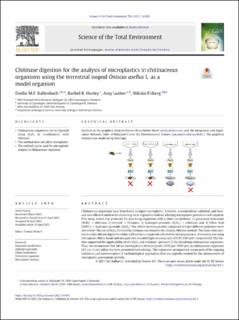| dc.contributor.author | Kallenbach, Emilie | |
| dc.contributor.author | Hurley, Rachel | |
| dc.contributor.author | Lusher, Amy | |
| dc.contributor.author | Friberg, Nikolai | |
| dc.date.accessioned | 2021-08-17T08:42:54Z | |
| dc.date.available | 2021-08-17T08:42:54Z | |
| dc.date.created | 2021-07-16T16:37:49Z | |
| dc.date.issued | 2021 | |
| dc.identifier.issn | 0048-9697 | |
| dc.identifier.uri | https://hdl.handle.net/11250/2768701 | |
| dc.description.abstract | Chitinaceous organisms have been found to ingest microplastic; however, a standardised, validated, and time- and cost-efficient method for dissolving these organisms without affecting microplastic particles is still required. This study tested four protocols for dissolving organisms with a chitin exoskeleton: 1) potassium hydroxide (KOH) + chitinase, 2) Creon® + chitinase, 3) hydrogen peroxide (H2O2) + chitinase, and, 4) Nitric Acid (HNO3) + hydrogen peroxide (H2O2). The effects on microplastics composed of eight different polymers were also tested. The use of H2O2 followed by chitinase was found to be a highly efficient method. The three other protocols either did not digest the chitin sufficiently or negatively affected the tested polymers. A recovery test using microplastic fibres, beads and tyre particles revealed high recovery rates of 0.85, 0.89 and 1 respectively. This further supported the applicability of the H2O2 and chitinase (protocol 3) for dissolving chitinaceous organisms. Thus, we recommend that future investigations of microplastic (0.05 μm–5000 μm) in chitinaceous organisms (0.3 cm–5 cm) utilise the here presented methodology. This represents an important component of the ongoing validation and harmonization of methodological approaches that are urgently needed for the advancement of microplastic assessments globally. | en_US |
| dc.language.iso | eng | en_US |
| dc.publisher | Elsevier | en_US |
| dc.rights | Navngivelse 4.0 Internasjonal | * |
| dc.rights.uri | http://creativecommons.org/licenses/by/4.0/deed.no | * |
| dc.title | Chitinase digestion for the analysis of microplastics in chitinaceous organisms using the terrestrial isopod Oniscus asellus L. as a model organism | en_US |
| dc.type | Journal article | en_US |
| dc.type | Peer reviewed | en_US |
| dc.description.version | publishedVersion | en_US |
| dc.rights.holder | Copyright 2021 The Author(s) | en_US |
| dc.source.articlenumber | 147455 | en_US |
| cristin.ispublished | true | |
| cristin.fulltext | original | |
| cristin.qualitycode | 2 | |
| dc.identifier.doi | 10.1016/j.scitotenv.2021.147455 | |
| dc.identifier.cristin | 1921965 | |
| dc.source.journal | Science of the Total Environment | en_US |
| dc.identifier.citation | Science of the Total Environment. 2021, 786, 147455. | en_US |
| dc.source.volume | 786 | en_US |

